St George's Mushrooms
By Mike on Sunday, April 20, 2008, 23:35 - Permalink
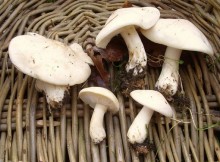 I went out looking for morels, but found none. My trip wasn't entirely fruitless though, as I happened across a small patch of St george's Mushrooms.
I went out looking for morels, but found none. My trip wasn't entirely fruitless though, as I happened across a small patch of St george's Mushrooms.
Identification Of Wild Fungi
The description here is not intended to be sufficient for conclusive identification of these wild fungi - the reader should understand that the possible outcomes of misadventure with wild-gathered fungi include serious illness and death.IT IS YOUR OWN RESPONSIBILITY to take adequate steps in identifying any fungi you gather for the table - doubly so if you are intending to share them with someone else.
Informal descriptions, such as the one on this page, are not adequate for full identification - it's just good sense to fully and independently verify everything you read here.
Rules of thumb or folk wisdom identification methods are frequently unreliable.
Consult a comprehensive identification guide (I recommend Roger's Mushrooms (site no longer available - see here) and Wild Mushrooms Online) or best of all, talk to a living human expert mycologist.
What are St George's Mushrooms?
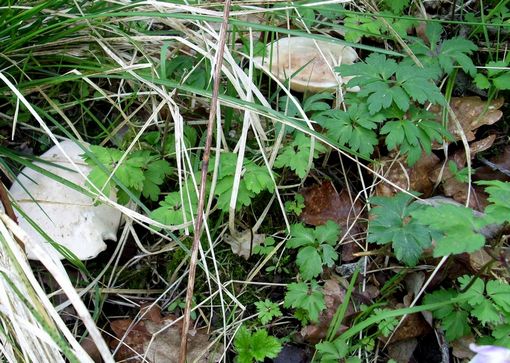
Calocybe gambosa (syn.Tricholoma gambosum) - these chunky, creamy-white fungi take their name from St George's day (23 April), which is around about the time of year they commonly appear - very often coinciding exactly with the time when the bluebells start to come out.
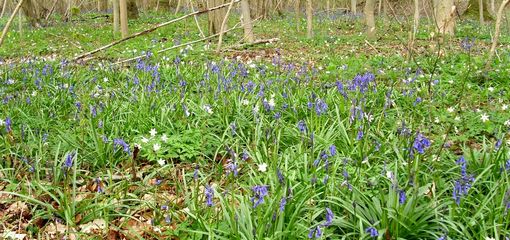 They're found in deciduous woodland (often in the same sort of woodland as bluebells) or pastures and are typically up to 12cm across, with a cap that starts out pale creamy white and convex in young specimens, becoming pale buff and convex in older ones.
They're found in deciduous woodland (often in the same sort of woodland as bluebells) or pastures and are typically up to 12cm across, with a cap that starts out pale creamy white and convex in young specimens, becoming pale buff and convex in older ones.
The gills are also off-white in colour.
Most distinctive is the smell - it is commonly described as 'mealy' - meaning smelling like milled grain - and the aroma is somewhat reminiscent of uncooked pastry, however, I think the smell is somewhere between mealy and new leather.
Picking St George's Mushrooms
I find the larger specimens to be a bit too soggy and fibrous for my liking, so I only pick the smaller, younger ones - paler in colour and with a cap that still remains convex in shape - I leave the older ones to continue dropping their spores and ensure the continued survival of the species.
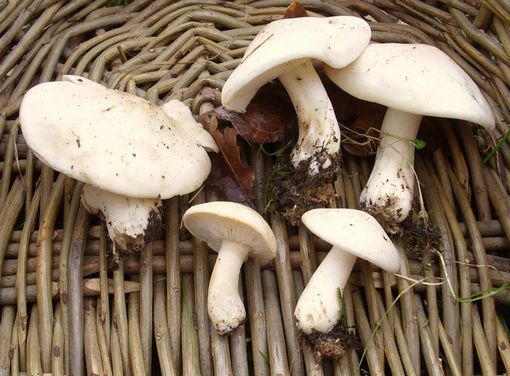 When picking mushrooms, it's best to use a basket or some other open container into which they can be gently placed. A plastic bag is far from ideal, as the condensation that collects in even a very short time can quite quickly ruin your harvest.
When picking mushrooms, it's best to use a basket or some other open container into which they can be gently placed. A plastic bag is far from ideal, as the condensation that collects in even a very short time can quite quickly ruin your harvest.
Also, take care to place the mushrooms into the container lying on their sides, or else trim off the soil-covered base of the stem with a sharp knife - if you put the mushrooms into the basket gill-side-up, vibration in transit will shake particles of dirt off the stem and they will drop in between the gills, where they will be impossible to remove
In The Kitchen
It would be enough of a treat just to be picking any mushrooms in spring (most other wild mushrooms appear in autumn), but on top of that, it happens to be the case that St George's Mushrooms are really excellent eating.
They feel solid and substantial - and unlike many other mushrooms that cook away to almost nothing, these don't lose much volume at all - instead, they just turn juicy and tender.
Cooking
Don't be put off by the slightly odd aroma - this disappears entirely during cooking.
I think most wild mushrooms are great just lightly fried and served on buttered toast, but I decided to use these in a quiche.
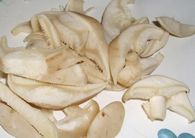 I cut off the stems and brushed the caps with kitchen paper to remove any adhering dirt, then I cut them into 1 cm thick slices
I cut off the stems and brushed the caps with kitchen paper to remove any adhering dirt, then I cut them into 1 cm thick slices
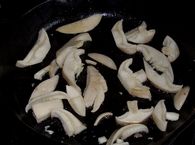 I gently fried them in a little oil
I gently fried them in a little oil
Then I packed them into some little shortcrust pastry cases, along with some little pieces of fried bacon and a couple of sliced cherry tomatoes.
 I topped this up with beaten egg and milk, and added a little pinch of grated cheddar, then baked in a hot oven until the top was golden and puffy
I topped this up with beaten egg and milk, and added a little pinch of grated cheddar, then baked in a hot oven until the top was golden and puffy
And it was good. There's never enough of a good thing like this though, so I think we could be going to look for more next weekend...
